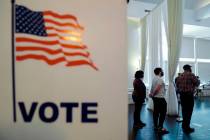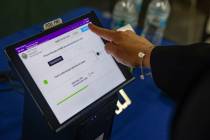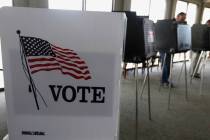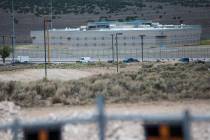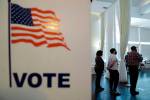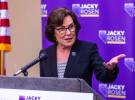It’s not 2009 anymore
Crashed revenues. A sour economy. Desperate pleas for tax increases amid record joblessness.
It sure looks a lot like 2009 all over again. The 2011 Legislature convenes Monday with the stakes largely unchanged from two years ago, when temporary tax increases, over-optimistic revenue projections and a federal bailout let Nevada lawmakers kick the can on critical fiscal issues created by decades of unsustainable spending increases.
A Republican governor who proposes balancing the state's operating budget through cuts and revenue shifts. Democrats determined to write and pass their own spending plan. Each party relying on disparate sets of numbers to define their agendas.
Those story lines are plenty familiar to Nevada voters. But a completely different set of dynamics will shape this year's session, and these forces already have created deep rifts between the major parties -- and deeper doubts about whether they can be resolved in just four months.
It most certainly is not 2009 anymore.
The new governor
At the top of the executive branch, the very popular, highly visible Gov. Brian Sandoval replaces the widely disliked, nearly invisible Jim Gibbons.
In 2009, Gibbons was more than two years removed from a narrow election victory and weighed down by personal baggage. His influence was limited to unifying lawmakers against his no-new-taxes pledge, and in driving them to pass a budget in plenty of time to override his veto. Gibbons had no presence in the Legislative Building.
Sandoval, on the other hand, breezed to his November election win, getting broad support throughout the state, including a healthy share of Democratic voters in Clark County. And he did it with the same fiscal positions as Gibbons, promising no new taxes and a spending rollback.
Armed with this fresh political capital, the former assemblyman, attorney general and federal judge is reaching out to lawmakers from both parties, not ignoring them. Sandoval is making his case that raising taxes on consumers, tourists and businesses would hinder the state's recovery and discourage hiring. And he's calling out Democrats for using bogus budget figures to exaggerate the extent of the cuts he has sought.
The bully pulpit of the governor's office cannot be underestimated -- it hasn't been used effectively in Nevada for years.
Two-thirds
Of course, Sandoval's opposition to tax increases will be irrelevant if Democratic leaders can build a two-thirds supermajority. That margin is required not only to pass tax increases -- the result of a voter-approved constitutional amendment -- but also to override Sandoval's promised veto.
In 2009, the Legislature's majority Democrats had the votes to raise taxes from day one. Their margin in the Assembly was 28-14, exactly two-thirds, rendering minority Republicans powerless to block or leverage anything. In the Senate, the majority was 12-9, but Democrats knew term-limited Minority Leader Bill Raggio, R-Reno, could be counted on to cross Gibbons and deliver the GOP votes needed to pass tax hikes.
Those numbers allowed the Legislature to work in a deliberate manner and build a new budget from scratch with the tax increases needed to fund it. Lawmakers adjourned on time, completing their business in the constitutionally mandated 120 days.
Today, it's a much different story. Republicans not only made gains in November, picking up one seat in the Senate and two in the Assembly, but their caucuses became much more fiscally conservative in the process. That reality compelled Raggio to vacate his leadership post -- his talk of a new round of tax increases and his fall endorsement of Democratic U.S. Sen. Harry Reid were too much for his caucus to tolerate.
Then Raggio surprised everyone by quitting the Legislature altogether last month, rather than complete his final term. He was replaced by Republican Greg Brower, who immediately declared his full support for Sandoval -- and his firm opposition to tax increases.
Senate Majority Leader Steven Horsford, D-Las Vegas, no longer has three Republican votes to raise taxes. He currently has just one: the term-limited Dean Rhodes, R-Tuscarora, a longtime Raggio loyalist. In fact, Horsford might not even have the full support of his own caucus. Sen. John Lee, D-North Las Vegas, hasn't been supportive of the idea.
Last week, Senate Minority Leader Mike McGinness, R-Fallon, and Assembly Minority Leader Pete Goicoechea, R-Eureka, signed an open letter on behalf of their caucuses declaring solidarity with Sandoval.
"The message you (voters) sent in November was far more practical than partisan," the letter says. "It wasn't about which political party should lead, but rather how government should operate. Legislative Republicans heard the message and maintain a firm commitment to sustaining any Governor's veto of any bill that grows government, raises taxes or reapportions government boundaries that unfairly benefit either political party."
The road to tax increases, freshly paved and clearly marked two years ago, has been blown up and blocked off.
The party without a plan
Democrats' calls for tax increases are quite ironic, considering most of them campaigned as fiscal conservatives in 2008 and 2010 and omitted their party affiliation from mailers and handouts.
Horsford famously said "I won't support tax increases" during his 2008 race. And Assembly Speaker John Oceguera, D-Las Vegas, tailored last year's campaign mailers to the tea-party climate, using one to declare: "Tough times demand tough stands. John Oceguera believes we need to cut back the size of government. And he's building strong support to get the job done." Another flier said, "When it comes to cutting the size of government, John Oceguera is taking the lead."
As they did in 2009, supposedly austere Democrats have turned loose the state's class of professional agitators, from public employee unions to liberal activists to students to nonprofit and social service administrators -- the people who get them elected. They want Republicans, who actually intend to stick by the campaign rhetoric that got them elected, to be shamed in the media even though they clearly have the support of the state's silent majority and struggling businesses.
Meanwhile, Democrats will forward no specific budget of their own for debate, thereby immunizing themselves from competing criticism. They're calling on businesses to share in the state's sacrifice by providing "revenue enhancements." As though 200,000 lost jobs and untold hundreds of business closures aren't sacrifice enough.
Democrats can't win elections on their agenda. They're scared to even say the words "tax increases." Yet they act as though they have a mandate from the public.
At what price compromise?
So how do Democratic lawmakers clear the way to get the new spending money they want?
Two years ago, Raggio's price for supporting tax increases was remarkably cheap. He leveraged a slight adjustment in the formula used to calculate the pension benefits of future government hires, and he made bumps in the sales, motor vehicle and payroll taxes sunset on June 30, 2011. That was it.
This year, any Republican who might be willing to deal is going to ask for a whole lot more than Raggio did.
Most of the reform agenda Sandoval outlined in his State of the State speech has no chance of passing either house. Over the years, Democrats, at the behest of public employee unions, have killed legislation that promotes school choice or scales back public-sector retirement benefits.
If Democrats expect a handful of Republicans to incur the wrath of their party, their base and their governor, those betrayers are going to want Democrats to suffer the same kind of backlash.
That means trading votes on a Democratic spending plan for most of Sandoval's wish list: putting all future government hires into a defined-contribution, 401(k)-style retirement account; ending teacher tenure; opening public employee contract negotiations to the press and the public at the least, if not banning collective bargaining for local governments altogether; and vouchers that cover private school tuition.
Plenty of Democrats don't believe in compromise if the result is what they consider bad policy. This year, such a principle will get them a whole lot of nothing.
Power play
The greatest difference between 2009 and 2011, however, is redistricting. Lawmakers will redraw congressional district boundaries to include a fourth Nevada seat, and they'll create new maps for the state Senate and Assembly. As the old saying goes, it's the time when politicians get to choose their voters.
There is no separating redistricting from the budget debate. Party leaders use redistricting as a carrot and a stick in counting votes. Those who play nice and follow the party line will get an easier path to re-election in 2012 and beyond, a "safe seat" that will scare away viable challengers from the other party. Those who don't go along to get along will find themselves in competitive campaigns, representing entirely different neighborhoods.
Northern Nevada lawmakers, who stand to have a few of their seats redrawn inside Clark County as part of reapportionment, have called for an expansion of the Legislature to preserve what's left of their voice. It's a card Southern Nevada Democrats might very well play to entice rural Republican defectors to vote for tax increases.
Sandoval has insisted that redistricting result in balanced populations within congressional, Senate and Assembly seat boundaries. That end alone would be to the GOP's advantage because Democratic lawmakers currently represent districts with much smaller populations. Despite their minorities in both houses of the Legislature, Republican lawmakers actually represent a majority of the state's voters -- a fact that gives them higher ground in holding the line on taxes.
Numbers game
With so many dollar figures being thrown around, it's difficult to make sense of how much of a reduction they represent when compared with current spending levels -- if they're a reduction at all.
Democrats claim that Nevada has a budget "hole" approaching $3 billion. Sandoval says it's about $1.2 billion, driven largely by the disappearance of federal "stimulus" money.
Sandoval has proposed a $5.8 billion spending plan for 2011-13, which is slightly less than the $6.2 billion the state is projected to spend in the biennium ending June 30. But it's way below the $8.3 billion various officials claimed needed to be spent in order to "return to normal service levels," whatever that means. That figure equates to a 34 percent spending increase. It's a fantasy -- but it lets Democrats claim Sandoval is gutting the government by $2.5 billion.
Another tax-hiking tactic claims Sandoval wants to cut $1 billion from the current budget. But that uses the $6.8 billion budget passed in 2009 as a baseline, not the reduced, $6.2 billion plan agreed to in special session when the economy failed to rebound.
That $6.2 billion is still more than the $5.9 billion Nevada spent from 2007-09. In other words, the current budget, "Draconian cuts" and all, is still a net spending increase over the biennium before.
Sandoval's plan for 2011-13 is, as he pointed out in his State of the State address, "within 1 percent of general fund spending in 2007."
The 5 percent pay cut he wants imposed on state workers is essentially a take-back of the 4 percent, across-the-board raise they received in the summer of 2008, even as the economy was starting its death spiral. Had workers agreed to give up that raise back then, they probably wouldn't have to make as steep a sacrifice now, because the state would have realized three years of salary savings.
Two years ago, lawmakers could have made the difficult decisions they face today if they had refused $450 million in stimulus funds. No federal bailout is coming in 2011.
It's definitely not 2009 anymore.
Glenn Cook (gcook@reviewjournal.com) is a Review-Journal editorial writer.








